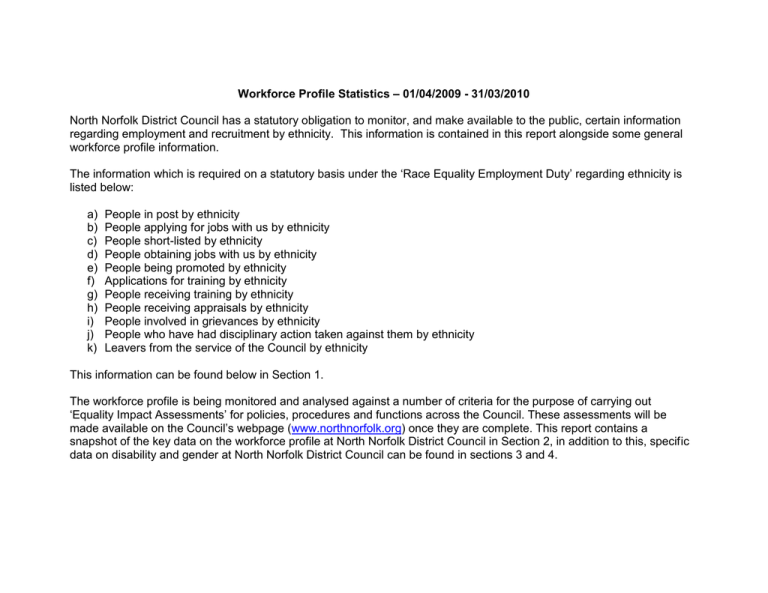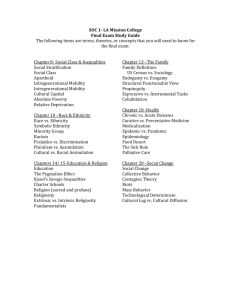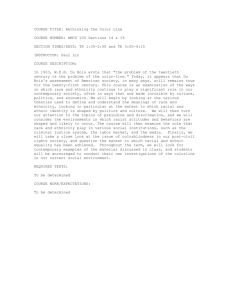– 01/04/2009 - 31/03/2010 Workforce Profile Statistics
advertisement

Workforce Profile Statistics – 01/04/2009 - 31/03/2010 North Norfolk District Council has a statutory obligation to monitor, and make available to the public, certain information regarding employment and recruitment by ethnicity. This information is contained in this report alongside some general workforce profile information. The information which is required on a statutory basis under the ‘Race Equality Employment Duty’ regarding ethnicity is listed below: a) b) c) d) e) f) g) h) i) j) k) People in post by ethnicity People applying for jobs with us by ethnicity People short-listed by ethnicity People obtaining jobs with us by ethnicity People being promoted by ethnicity Applications for training by ethnicity People receiving training by ethnicity People receiving appraisals by ethnicity People involved in grievances by ethnicity People who have had disciplinary action taken against them by ethnicity Leavers from the service of the Council by ethnicity This information can be found below in Section 1. The workforce profile is being monitored and analysed against a number of criteria for the purpose of carrying out ‘Equality Impact Assessments’ for policies, procedures and functions across the Council. These assessments will be made available on the Council’s webpage (www.northnorfolk.org) once they are complete. This report contains a snapshot of the key data on the workforce profile at North Norfolk District Council in Section 2, in addition to this, specific data on disability and gender at North Norfolk District Council can be found in sections 3 and 4. Section 1: Statutory Data The following data is correct for the year 01 April 2009 – 31 March 2010, unless otherwise stated. (Where static workforce profile figures are used as comparisons, these are taken at 31 March 2010) a) People in post by ethnicity (as at 31/01/10) As Chart 1 below shows, the overwhelming majority of employees at North Norfolk District Council are of White British origin. O th er O th er W hi te sa y As ia n to Pr ef er no t Iri O th er Br itis h W hi te Ch i sh 350 300 250 200 150 100 50 0 ne se No of employees Employees by ethnicity Ethncity Chart 1: Employees by ethnicity (31/03/2010) b) People applying for jobs with us by ethnicity (01/04/09-31/03/10) c) People short-listed by ethnicity(01/04/09-31/03/10) d) People obtaining jobs with us by ethnicity (01/04/09-31/03/10) Applications Application Withdrawn Shortlisted Successful Number Percentage Number Percentage Number Percentage Number Percentage Total of original applicants 370 100 117 32 13 4 22 6 White British 329 0.00 107 91.45 12 92.31 19 86.36 White Other 2 0.54 0 0.00 0 0.00 0 0.00 Black African 0 0.00 0 0.00 0 0.00 0 0.00 Chinese 3 0.81 3 2.56 1 7.69 2 9.09 Irish 2 0.54 2 1.71 0 0.00 1 4.55 Mixed other 2 0.54 1 0.00 0 0.00 0 0.00 Mixed white Asian Mixed white Black Carribean 1 0.27 0 0.00 0 0.00 0 0.00 0 0.00 0 0.00 0 0.00 0 0.00 Pakistani 0 0.00 0 0.00 0 0.00 0 0.00 Other 1 0.27 0 0.00 0 0.00 0 0.00 30 8.11 4 3.42 0 0.00 0 0.00 Not stated Table 1: Recruitment information for the period 01/04/09-31/03/10 e) People being promoted by ethnicity (01/04/09-31/03/10) In the period 01/04/09-31/03/10 there was only one internal promotion, therefore no analysis of the data has been carried out. f) Applications for training by ethnicity g) People receiving training by ethnicity At North Norfolk District Council, applications for training are made via the appraisal process. These training needs are then collated and form the basis for the ‘Corporate Training Plan’. Table 2 below shows the number of requests made and the number of training opportunities offered as a result of these requests. As the figures show, 100% of those who requested training were offered this training. 2009 Ethnicity Total White British White Other Chinese Irish Asian Other Other Not known Workforce Totals as at 31/03/10 Number % 342 100 Training Requested - 2009 Number % 19 5.56% Training Offered 2009 Number % 19 100.00% Training offered, but declined - 2009 Number % 2 10.53% Training Offered and Received 2009 Number % 17 89.47% 328 95.91% 18 5.49% 18 100.00% 2 10.53% 17 89.47% 1 1 1 0.29% 0.29% 0.29% 0 0 1 0% 0% 100% 0 0 1 0% 0% 100% 0 0 0 0% 0% 0% 0 0 1 0% 0% 100% 1 4 6 0.29% 1.17% 1.75% 0 0 0 0% 0% 0% 0 0 0 0% 0% 0% 0 0 0 0% 0% 0% 0 0 0 0% 0% 0% Table 2: Applications for training and training received via the Corporate Training Plan for period 01/04/09 – 31/03/10 In addition to this, employees may undertake a professional or technical qualification. This is covered by a training indemnity and the data for these courses by ethnicity is shown below in Table 3. Ethnicity Total White British White Other Chinese Irish Asian Other Other Not known 2009/10 Training Workforce Totals Indemnities Number % Number % 342 100 15 100 328 95.91% 14 93.33% 1 1 1 0.29% 0.29% 0.29% 0 0 0 0% 0% 0% 1 4 6 0.29% 1.17% 1.75% 0 0 1 0% 0% 6.67% Table 3: Professional/technical training courses covered by an indemnity by ethnic group There are additional training activities which occur at a departmental level, which are not part of the Corporate Training Plan or not covered by a training indemnity. Central records are not currently kept on this so it is not possible to report on this data. h) People receiving appraisals by ethnicity During the 2009 appraisal cycle, 32 employees did not receive an appraisal. This means that approximately 10% of the workforce did not receive an appraisal for the 2009 cycle. 30 of these employees were of White British origin and the ethnic origin of the remaining two employees is not known. This was an unusually high number of appraisals not completed (compared to 16 in the previous year). 12 were not completed due to the employee being away on long term sick or maternity leave, but the reason the remaining appraisals were not completed is not known. i) People involved in grievances by ethnicity There were no grievance cases during the period 01/04/09 - 31/03/10. j) People who have had disciplinary action taken against them by ethnicity There were no formal disciplinary cases during the period 01/04/09 – 31/03/10. There were two informal cases but based on the small numbers it is not felt that analysis would be worthwhile. k) Leavers from the service of the Council by ethnicity A total of 23 employees left employment with the Council between 01/04/09 - 31/03/10. 100% of these were of White British origin. Section 2: Additional Workforce Data Gender Disability Employees by disability status Employees by gender 27, 8% 132, 39% Male Disabled Female Not Disabled 210, 61% 315, 92% Age Full and part time employees Employees by age band No of employees 100 80 80 65 50 60 40 27 7 1 0 >20 20-29 30-39 40-49 50-59 60-64 Age Band 65+ No of employees 112 120 20 Full and part time employees by gender 140 120 100 80 60 40 20 0 131 113 79 Full time Part time 19 Male Female Gender *Full time is 37 hours or 1.00 FTE (Full Time Equivalent), and Part time is counted as anything less than 37 hours or 1.00 FTE Gender of top 5% of earners Labour turnover by gender The total labour turnover for the period 01/04/09-31/03/10 was 6.9%. Gender split of top 5% of earners In total there were 23 leavers (this does not include seasonal or ‘temp’ workers). 6, 30% Male Female 14, 70% Of these 23, 8 were male and 15 were female. When the turnover is broken down by gender, the turnover of males is lower at 6.3% compared to turnover of female employees which was 7.3%. Section 3: Data on Disability status of employees i. Proportion of disabled people at various levels in the organisation SCP Range Grade New entrants 1 2 3 4 5 6 7 8 9 10+ Total People 4-7 8-12 13-17 18-21 23-26 28-31 33-36 37-40 42-45 46-49 50+ Disabled People 4 7 55 78 29 48 42 29 28 12 10 0 0 5 8 3 3 3 3 1 1 0 % of people in the grade who are disabled 0% 0% 9.1% 10.3% 10.3% 6.3% 2.4% 3.5% 3.6% 8.33% 0% % of total disabled people at that grade 0% 0% 18.52% 29.63% 11.11% 11.11% 11.11% 11.11% 3.7% 3.7% 0% Table 4: Proportion of disabled people at various levels in the organisation ii. Disabled people at different stages of the recruitment process Applications Application Withdrawn Shortlisted Successful Number Percentage Number Percentage Number Percentage Number Percentage 370 100 117 32 13 4 22 6 Disabled - Y 19 5.14 5 38.46 1 100.00 0 0.00 Disabled - N 22 5.95 13 260.00 0 0.00 3 13.64 329 88.92 99 1980.00 12 1200.00 19 86.36 Total of original applicants Disabled - Prefer not to say/not known Table 5: Disabled people at different stages of the recruitment process iii. Promotions In the period 01/04/09 – 31/03/10 there was only one internal promotion, therefore no analysis of the data has been carried out. iv. Discipline There were no formal disciplinary cases during the period 01/04/09 – 31/03/10. There were two informal cases but based on the small numbers it is not felt that analysis would be worthwhile. v. Grievance There were no grievance cases during the period 01/04/09 - 31/03/10. vi. Appraisals For the appraisal year 2009, there were 4 outstanding appraisals for disabled employees. Two of these were due to long term sickness and the reasons for non-completion of the remaining 2 are not known. vii. Training Two of the training indemnities in place for 2009/10 covered employees who had declared themselves as disabled. Disability Status Total Disabled Y Disabled N 2009/10 Training Workforce Totals Indemnities Number % Number % 342 100 15 100 27 7.89 2 13.33 315 92.11 13 86.67 Table 6: Training indemnities covering disabled employees Information on corporate training (i.e. that which is determined through training needs identified at appraisal) is shown below, broken down by disability status. Disability Status Total Disabled Y Disabled N Workforce Totals as at 31/03/10 Training Requested - 2009 Number 342 27 315 Number 19 0 19 % 100 7.89 92.11 % 5.56% 0.00% 6.03% Training Offered 2009 Number 19 0 19 % 100.00% 0.00% 100.00% Training offered, but declined - 2009 Number 2 0 2 % 10.53% 0.00% 10.53% Training Offered and Received 2009 Number % 17 89.47% 0 0.00% 17 89.47% Table 7: Corporate training by disability status As shown in table 7 above, none of the employees who requested formal training through this process were disabled. In any case, it is important to note that decisions on corporate training are made based on a business case basis and by level of demand. Section 4: Data on Gender i. Recruitment Applications Application Withdrawn Shortlisted Successful Number Percentage Number Percentage Number Percentage Number Percentage Total of original applicants 370 100 117 32 13 4 22 6 M 217 58.65 56 47.86 3 23.08 11 50.00 F 153 41.35 61 52.14 10 76.92 11 50.00 Table 8: Gender split in the recruitment process ii. Promotions In the period 01/04/09 – 31/03/10 there was only one internal promotion, therefore no analysis of the data has been carried out. iii. Discipline There were no formal disciplinary cases during the period 01/04/09 – 31/03/10. There were two informal cases but based on the small numbers it is not felt that analysis would be worthwhile. iv. Grievance There were no grievance cases during the period 01/04/09 - 31/03/10. v. Training Gender Total M F 2009/10 Training Workforce Totals Indemnities Number % Number % 342 100 15 100 132 38.59649 8 53.33 210 61.40351 7 46.67 Table 9: Gender split of training indemnities This table shows that 15 employees had a training agreement that was covered by a training indemnity. There were slightly more male than female employees. 2009 Gender Total M F Workforce Totals as at 31/03/10 Number % 342 100 132 38.59649 210 61.40351 Training Requested - 2009 Number % 19 5.56% 6 4.55% 13 6.19% Training Offered 2009 Number % 19 100.00% 6 4.55% 13 6.19% Training offered, but declined - 2009 Number % 2 10.53% 2 33.33% 0 0.00% Training Offered and Received 2009 Number % 17 89.47% 4 66.67% 13 100.00% Table 10: Corporate training by gender This table shows the breakdown of requests and training received by gender. This ‘Corporate Training’ is requested at appraisal. 66.67% of males who requested training received it, compared to 100% of females. However all those who requested training were offered the training. It is also important to note that decisions on corporate training are made based on a business case basis and by level of demand. vi. Appraisals Workforce totals Total M F Number 342 132 210 % 100 38.60 61.40 2009 Appraisals received Number % 310 90.64 113 85.61 195 92.86 Appraisals not received Number % 32 9.36 19 14.39 15 7.14 Table 11: Appraisals received in 2009 cycle by gender







